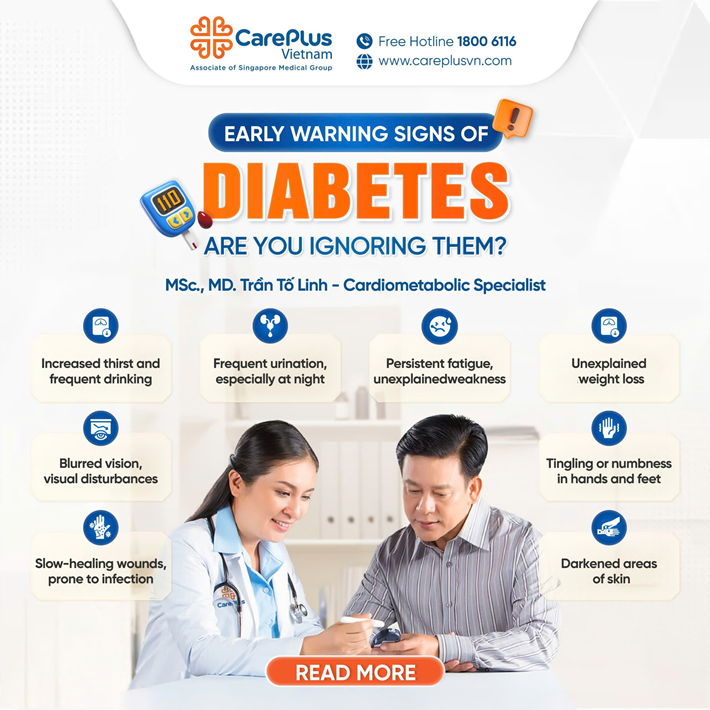EARLY WARNING SIGNS OF DIABETES – ARE YOU OVERLOOKING THEM?

6/6/2025 10:32:03 AM
Diabetes mellitus is a chronic metabolic disorder characterized by persistent hyperglycemia due to insulin deficiency, insulin resistance, or both. Insulin is a hormone secreted by the pancreas that regulates blood glucose levels. This metabolic dysregulation not only impairs glucose utilization but also leads to progressive damage to multiple organ systems, especially the cardiovascular system, kidneys, eyes, and nervous system. If not detected and properly managed, diabetes can progress silently, resulting in serious complications, diminished quality of life, and increased mortality risk.
This article is medically reviewed by Dr. Tran To Linh, MSc – Cardiometabolic Specialist.
🔻Classification of Diabetes
According to the American Diabetes Association (ADA), diabetes is classified into the following major categories:
▪️ Type 1 Diabetes Mellitus: Caused by autoimmune destruction of pancreatic beta cells, leading to absolute insulin deficiency. It typically develops in younger individuals and progresses rapidly, requiring lifelong insulin therapy.
▪️ Type 2 Diabetes Mellitus: The most common form, often associated with obesity and a sedentary lifestyle. Pathogenesis involves insulin resistance combined with progressive pancreatic beta-cell dysfunction.
▪️ Gestational Diabetes Mellitus (GDM): Diagnosed for the first time during pregnancy. It may resolve postpartum but significantly increases the risk of developing type 2 diabetes later in life.
▪️ Secondary Diabetes: Results from endocrine disorders (e.g., Cushing’s syndrome, hyperthyroidism), pancreatic diseases (e.g., chronic pancreatitis, pancreatic cancer), or side effects of medications such as corticosteroids or antipsychotic drugs.
🔻Clinical Manifestations Suggestive of Diabetes
🔹 Polydipsia (Excessive Thirst)
- Persistent, unrelenting thirst even after adequate fluid intake
- Must be differentiated from thirst due to hot weather, physical exertion, or dehydration from diarrhea
🔹 Polyuria (Frequent Urination), Especially Nocturia
- Increased urine volume without dysuria or hematuria
- Osmotic diuresis caused by excess glucose in urine drawing water along
🔹 Chronic Fatigue or Unexplained Weakness
- Fatigue persists despite sufficient rest
- Caused by ineffective glucose utilization, leading to decreased cellular energy production
🔹 Unintended Weight Loss
- Rapid weight loss despite unchanged or even increased food intake
- Due to lipolysis and protein catabolism as alternate energy sources in the absence of adequate insulin
🔹 Visual Disturbances (Blurred Vision)
- Progressive blurring of vision, difficulty focusing
- Chronic hyperglycemia alters lens osmotic balance and damages retinal vasculature
🔹 Darkened Skin Patches (Acanthosis Nigricans)
- Common in body folds such as the neck, armpits, or groin
- Indicative of insulin resistance, often seen in overweight or obese individuals
🔹 Delayed Wound Healing and Increased Susceptibility to Infections
- Cuts or ulcers take longer to heal due to vascular damage, peripheral neuropathy, and immunosuppression
- Increased risk of infections: gingivitis, skin infections, urinary tract infections, etc.
🔹 Paresthesia – Numbness or Tingling in Hands and Feet
Sensations of pins and needles, burning, or numbness in the extremities
👉 Early sign of diabetic peripheral neuropathy caused by chronic nerve damage due to prolonged hyperglycemia
Diabetes is a complex condition that often progresses silently over many years before being diagnosed. Without proper glycemic control, it can lead to life-threatening complications such as myocardial infarction, stroke, end-stage renal disease, diabetic retinopathy leading to blindness, and limb necrosis.
Therefore, early screening, lifestyle modification, and optimal glycemic management are critical in preventing complications and improving long-term quality of life in patients with diabetes.